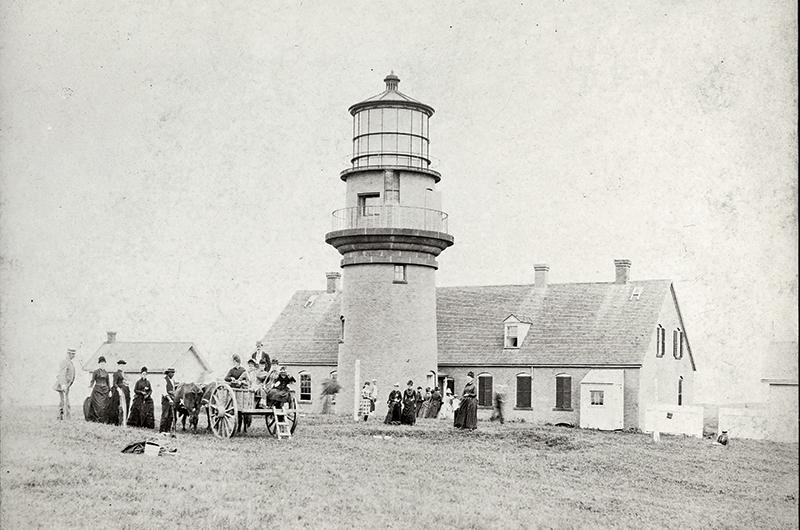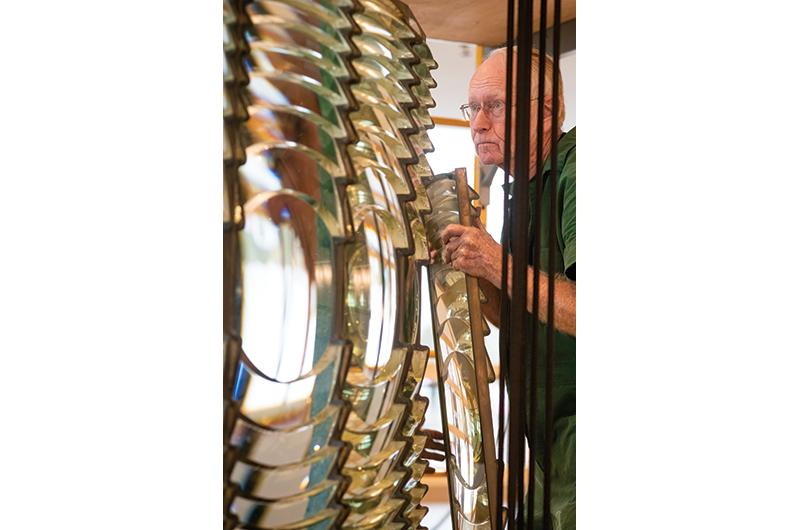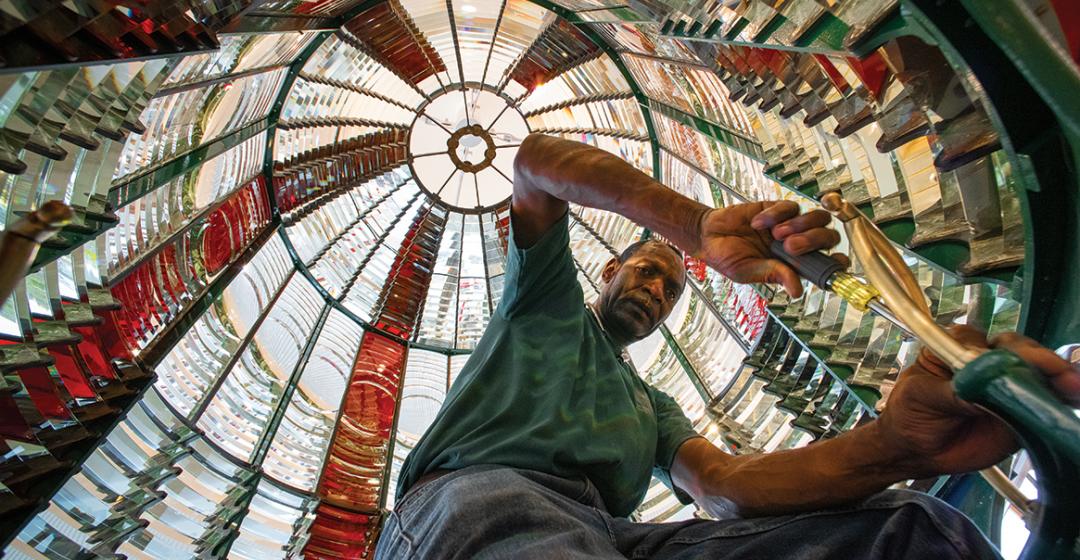Let’s start with the name Fresnel. It looks innocent enough: Fres-nel, one might think. But no, the s is silent. Fren-el is how Augustin (Aw-goost-n) was used to hearing his name in France, where he was born and lived, and where in 1822, five years before his death at the age of thirty-nine, he invented the prismatic lens that bears his name. His breakthrough in optical physics provided unprecedented concentration and projection of light. Lest you think this is old news, the principle behind Monsieur Fresnel’s breakthrough theory is used in the brake lights of your car, amplifying the light as you step on the brakes.
The lens represents thousands of years of development; the progenitor was the prehistoric fire on the beach, set to guide a fisherman home after dark, visible at best for three to five miles. The original wooden, octagonal lighthouse at Gay Head, built in 1799, had several different lighting systems, the best of which could be seen for twelve miles. But the Fresnel lens, which is now the heart of the new Martha’s Vineyard Museum in Vineyard Haven, could project a wick of firelight an astonishing twenty-one miles. Not even the electric aero beacon used today at the Gay Head Light can outshine that: the curvature of the earth gets in the way, blocking the signal. The farther a signal can be seen at night, the more time mariners have to prepare for treacherous waters, in this case the underwater rocks of Devil’s Bridge, a notorious shoal that has been the graveyard of many ships, most notably the passenger steamer City of
Columbus in 1884.
This Jules Verne–like mechanism is twelve feet tall and the beehive-shaped lens, formed by the systematic placement of 1,008 crystal glass prisms, is about seven feet in height and four feet wide. It is a First Order lens, the largest type built at the time of its installation. According to James S. Woodward, who restored the lens for the museum and who is widely regarded as the expert on all things Fresnel, the original ordering system, from First Order to Sixth, was conceived simply as an indication of brightness: “Coming from the open sea, the first light you would see would be a First Order, then the Second Order, and the rest would follow as your ship got closer to land.” The West Chop Light, by contrast, still has its Fourth Order Fresnel lens.

The Gay Head lens was so extraordinary that the Parisian firm Henry LePaute, which built it in 1854, entered it in the Exposition Universelle of 1855 in Paris. The smooth silence of the massive lens as it rotated with the mere push of a finger surely helped the judges confirm its perfect balance. It won the top prize at the exposition, a gold medal, before being packed up and shipped to Edgartown.
One of the primary advantages of Fresnel’s optical innovations, including the use of prisms, is that they cut down on the amount of glass necessary for light amplification, which significantly reduced the weight and size of the unit. There were no millstone-sized glass lenses to transport across the ocean. Nonetheless, the components weigh more than a ton and transporting them over the twenty miles of primitive roads to Gay Head was no simple matter. It took “eight yoke of oxen to transport the heavy iron railing for the catwalk,” the Vineyard Gazette reported, “but it took 40 yoke of oxen to move the 60 frames of glass prisms and the multitudinous collection of machinery necessary to operate the new light.” Once arrived, a “lampist” – the term of art used by the U.S. Coast Guard to designate those who maintain the lens and its mechanism – puzzled the pieces together.
With everything installed, on December 1, 1856, a routine began that was repeated every night of the year for the next ninety-six years. The secondary, or assistant keeper, would fetch the fuel – sperm oil in the first years, then lard for its lower cost, then kerosene for lower cost still and better efficiency. Throughout the night, the fuel reservoir would be topped off and every half-hour a piston that forced the fuel up to the wick was cranked. The chariot wheels needed periodic lubrication, and the wick required trimming to burn efficiently. Keeping soot off the lamp, lens, and interior window surfaces was a constant chore, and removing ice, snow, salt, or clay dust might require going out on the upper balcony in weather fair and foul. Lastly, the 150-pound weight that dangled down the center of the lighthouse and powered the gravity-driven clockwork had to be cranked to the top of the tower every four hours, a job done quickly since the light did not rotate while the clockwork was being wound. That minute or two of stoppage was part of acceptable normal operations, but if a light keeper let the flame go out it was instant dismissal.
These preparations had been taken care of as the sun began to approach the western horizon. Then the lucerne, a tiny, one-by-two inch oil can with a cord wick, was lit and carried by a “wickie,” as the lighthouse keepers were known, up into the Fresnel to light the lamp. Matches, called “Lucifers” by the wickies, were absolutely prohibited.

The resulting signal was not a rotating beam of light, but a flash. The lens is arranged in a series of twenty-four flash panels, which created twenty-four flashes in one rotation of the lens. Originally all the flashes were white, but in 1874 red glass was added over six of the original flash panels, changing the lighthouse’s signal to white, white, white, red. The red flash panels are the most delicate part of the lens. Red glass with the greatest clarity requires gold in its manufacture, and because thinness guarantees maximum transparency, these panels, only a quarter-inch thick, are very fragile. The red was added to distinguish the Gay Head Light from other lighthouses on the East coast.
Three whites and a red, three whites and a red, three whites and red. Year in and year out for some 35,000 nights the Fresnel sent out its reassuring warning to mariners.
In advance of the Fresnel removal, the Coast Guard announced the lens would be given to the Boston Museum of Science. The Dukes County Historical Society (now the Martha’s Vineyard Museum) protested this jewel leaving the Island and raised funds to house the lens at their Edgartown campus. The Town of Gay Head also launched an effort to keep the Fresnel, but ultimately was unable to provide a home for the lens before its removal. There was (and in some quarters still is) disappointment in Gay Head that the Fresnel left town, but the choice between it leaving the Vineyard entirely or merely moving back down-Island was an obvious one.

Charles W. Vanderhoop Sr., a Gay Head Wampanoag who had been principal keeper at the lighthouse from 1920 to 1933, and the only Native American in U.S. history to ever hold that position, ceremonially lit the lens at its 1952 installation in Edgartown. “Folks in Gay Head wanted the Fresnel to stay in town,” his son Charles later told William Waterway for his book Gay Head Lighthouse: The First Light on Martha’s Vineyard (The History Press, 2014). “My father was a member of the Society....I remember when he lit the lens...he got all dressed up in his best keeper’s uniform. It was a nice way for the island to honor my father’s years of service.”
Lampists are rare these days, though probably not as rare as wickies. One day in 1999, after the Fresnel had been on display at the museum campus in Edgartown for forty-seven uneventful years, a visitor set the Fresnel spinning and then put a penny in the track on the “bearing table.” This caused the lens to jump the track, and it tore up the clockwork case, disabling the mechanism and causing general mayhem. The Coast Guard had only one lampist certified to work on a First Order Fresnel, James S. Woodward, who was given leave from his Civil Engineering Unit to come to the Island and help out.
Woodward’s work at that time stabilized the lens. In the process, he created what he called “an owner’s manual” to guide future maintenance. “Anytime I can get back here to work on this thing, I’d love to,” he told the Gazette when the work was completed. So when the time came in 2018 to move the Fresnel to its spacious new home in the old Marine Hospital, the museum knew who to call. Woodward, by then, had retired from the Coast Guard, but was doing business as The Lighthouse Consultant LLC.
He brought with him senior lampist Jim Dunlap, lampist Tommy Cumella, and apprentice lampist Leon Hodge, and over the course of several weeks the entire mechanism received a thorough cleaning as he and the crew removed corrosion, stabilized cracked panels, and replaced damaged or missing elements, with some parts sent off-Island for additional work. Crucial to its restoration is the green paint. That is how the Fresnel looked when it left the factory, and every lens was shipped with a can of that paint for touch-ups when needed.

“It was an honor to be able to work on such a prestigious lens, one of the first that the U.S. purchased,” Woodward said when the work was done this time, noting that he has been working on lenses for more than half a century and on this one on and off for nearly twenty years.
The Fresnel’s new pavilion, where visitors to the museum can admire the jewel-like prisms and meticulously crafted machinery from all angles, is spacious compared with the lantern room in the lighthouse, where the windows were only three feet from the lens. The new, and one assumes final home for the lens, is also a remarkably restful space, almost contemplative, which is appropriate perhaps for a hardworking lifesaver’s retirement in a former hospital for ailing mariners. A lifesaver, it’s worth noting, that was a tourist attraction from the moment it appeared at the Exposition Universelle of 1855 in Paris and throughout its long career on the cliffs.
To fully understand the impact of the arrival of the Fresnel at Gay Head and why it generated such attention, we must add the element of fire. Inside the lighthouse the opening night activity in 1856 may have been frenetic, as the many jobs involved in running the beacon were being done for the first time. But as the wick at the center of the Fresnel was touched with fire and the lens came to life that first night, those who had gathered below the light in witness were awestruck. It began slowly turning and flashing every ten seconds with bursts of light powerful enough to leap out twenty-one miles over the land, off the clifftop, and out to sea. This was unprecedented brilliance at night for people who knew only of candlelight.
As the Fresnel turned, beams of light were emanating in all directions and the prisms were twinkling as they passed around the central flame. The window glass surrounding the lens was passing the signal out over the waters, while also bouncing those beams and reflecting them back in the opposite rotation from the lens. Thus, in the blackness, there was an intense, glittering, swirling light show. At the time, it would have had the impact of going to Vegas or Disneyland. It was over the top.
Word of this amazing man-made phenomena began to filter out from Gay Head. By the 1880s, a typical ad for a “grand excursion” to Gay Head on “Captain Manter’s steamer Island Home” promised a “Brass Band Concert by the New Bedford Cornet Band,” a “sail around the spot of the ill-fated City of Columbus,” a visit to “a settlement of Indians,” and a tour of “the most magnificent Light on the coast”: the Gay Head Fresnel.




 5 comments
5 comments
Comments (5)